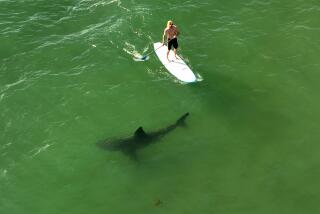COUNTYWIDE : Value of Sanctuary Sought in Study
It may be hard to estimate in dollars the value of a pristine natural area, but that is what Julie Reynolds will try to do over the next year with the Channel Islands National Marine Sanctuary.
Reynolds received a $15,000 grant from the National Oceanic and Atmospheric Administration and the California Sea Grant program. This fellowship program, headquartered at the University of California at San Diego’s Scripps Institute of Oceanography, matches graduate students interested in marine resource policy with state government agencies for paid fellowships.
“She’s going to try to come up with a figure for the value of the sanctuary,” said Lt. Cmdr. Stephen Jameson, the sanctuary manager.
Reynolds graduated from Pomona College in Claremont with a BA in government and public policy analysis, with an emphasis on environmental policy analysis.
She intends to continue her studies in graduate school.
The Channel Islands National Marine Sanctuary has an area of 1,252 square miles and is the largest of eight national sanctuaries.
It encompasses the waters surrounding Anacapa, Santa Cruz, Santa Rosa, San Miguel and Santa Barbara islands, and includes more than 100 shipwrecks and Chumash Indian sites.
Jameson said the undertaking, which is the first of its kind in the nation, will reveal how much revenue the sanctuary brings to the area through such activities as fishing and tourism.
Jameson and Reynolds said that they hope the study will also generate ideas for more ways to use the sanctuary for recreational and educational purposes without damaging the environment.
“We don’t want to exploit the area,” Reynolds said.
Reynolds is compiling a list of groups who use the ocean area, such as fishermen, divers, cruise ship operators and kelp harvesters.
She hopes to find out how much money these groups have made from their use of the sanctuary since it was established in 1980, and compare that to earnings in the area 10 years before.
Activities prohibited in the area since the sanctuary was designated are drilling for gas and oil, operating large barges and tankers, and dumping, Reynolds said.
More to Read
Sign up for Essential California
The most important California stories and recommendations in your inbox every morning.
You may occasionally receive promotional content from the Los Angeles Times.










